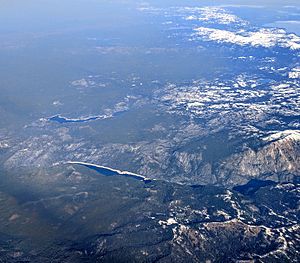Bear River Dam facts for kids
The Bear River Dam is a large dam located in Amador County, California. It sits to the east of Sacramento. This important dam helps create electricity and provides water for homes and towns. It is also known as the Upper Bear River Dam.
Contents
What is the Bear River Dam?
The Bear River Dam was built a long time ago in 1900. It is a type of dam called a rockfill dam, meaning it's made mostly of rocks and earth. The dam stands about 83 feet (25 meters) tall. It stretches for about 748 feet (228 meters) across the Bear River.
How Does the Dam Help Us?
The main purpose of the Bear River Dam is to hold back the Bear River. This creates a large lake called the Bear River Reservoir. The water from this reservoir is used for two very important things:
- Making electricity: The dam helps generate hydroelectric power. This means the moving water is used to spin turbines, which then create electricity.
- Providing water: The reservoir also supplies water for cities and towns to use.
The dam is owned and operated by the Pacific Gas and Electric Company (PG&E). PG&E is one of the biggest private owners of hydroelectric power plants in the United States. The Bear River Dam is one of their many dams.
Exploring Bear River Reservoir
The Bear River Reservoir is the lake created by the dam. It covers about 149 acres (60 hectares) when full. It can hold a lot of water, up to 6,818 acre-feet.
People can enjoy many activities at the reservoir, such as:
- Fishing
- Swimming
- Camping
However, it's important to know that the Upper Bear River Reservoir, which is the one created by this dam, can only be reached by walking. Because of this, not many people visit it.
Nearby Dams and Future Plans
Just downstream and to the west of the Bear River Dam, you'll find another dam and reservoir. This is called the Lower Bear River Reservoir. It is also owned by PG&E.
Engineers are also looking into a new idea for the Bear River Dam. They are thinking about using it as part of a "pumped-storage" project. This project would involve moving water between the Bear River Reservoir and the Salt Springs Reservoir. This process could help create even more electricity when it's needed most.


